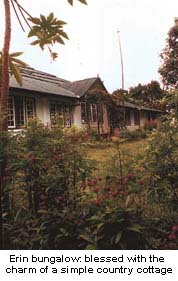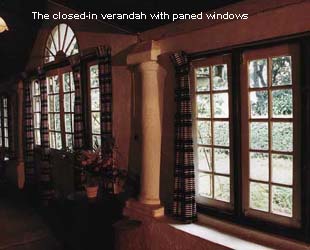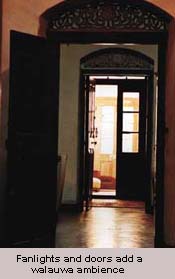

![]()
 Erin, so the story goes, was the beautiful young wife of the Irish planter
who owned the estate and bungalow which bears that name. The bungalow has
only 38 acres of tea to support it now and its heyday has long passed.
Yet for a couple retired from the hubbub of Colombo, it is a home as romantic
as it sounds.
Erin, so the story goes, was the beautiful young wife of the Irish planter
who owned the estate and bungalow which bears that name. The bungalow has
only 38 acres of tea to support it now and its heyday has long passed.
Yet for a couple retired from the hubbub of Colombo, it is a home as romantic
as it sounds.
History records that the plantation, which is at Galaha some 16 miles by road from Peradeniya railway station, was sold by Erin's husband to his head kangany, which is how it passed into Tamil ownership. Tracking it through various editions of Ferguson's Directory for the past 40 years, one can see that ownership of the plantation of 400 acres in tea was shared by up to nine people at a time until taken over in the 1970's under nationalisation.
The bungalow remained owner-occupied by descendants of the head kangany until it was bought in 1995 by Mr. and Mrs. Stanley Jayasekera. Mr. Jayasekera took early retirement from his job as Passenger Sales Manager with KLM in Colombo, choosing Erin as home because of its location and agreeable climate. In doing so he became the proprietor of a bungalow that has little of the grandeur of hill country estate residences, but all of the charm of a country cottage hideaway.
 Although it looks as though it is small and possibly abandoned from
its external appearance, because its narrow lobby entrance is closed and
shuttered, Erin is huge. It is a rambling bungalow totalling 6,800 square
feet in area. Instead of using the old entrance, access is through the
car port into a corridor at least 70 feet long. It runs the length of the
bungalow ending with a door to the servants quarters at the rear of the
building. The main rooms lead off this corridor which is paralleled by
another corridor at the opposite side of the bungalow. Both were originally
open verandahs. The columns that supported the verandah roof are still
to be seen where they have been incorporated in the additional exterior
wall.
Although it looks as though it is small and possibly abandoned from
its external appearance, because its narrow lobby entrance is closed and
shuttered, Erin is huge. It is a rambling bungalow totalling 6,800 square
feet in area. Instead of using the old entrance, access is through the
car port into a corridor at least 70 feet long. It runs the length of the
bungalow ending with a door to the servants quarters at the rear of the
building. The main rooms lead off this corridor which is paralleled by
another corridor at the opposite side of the bungalow. Both were originally
open verandahs. The columns that supported the verandah roof are still
to be seen where they have been incorporated in the additional exterior
wall.
Glass windows of ten panes each, swinging open on central pivots, seem to have come from a tea factory loft. With chairs spaced out along its length and a ceiling of dark stained boards, the main corridor is a delightful place to relax undisturbed by inclement weather.
 Off this corridor, the doors to the living room at the core of the house,
are solid wood set in walls of stone and sand (no cement) some 18 inches
thick. Interior doors have handles of cut glass, each in a different colour.
Ornately carved fanlights add a further refinement, giving this simple
bungalow the style of a walauwa.
Off this corridor, the doors to the living room at the core of the house,
are solid wood set in walls of stone and sand (no cement) some 18 inches
thick. Interior doors have handles of cut glass, each in a different colour.
Ornately carved fanlights add a further refinement, giving this simple
bungalow the style of a walauwa.
Light in the living room and some of the bedrooms comes from skylights positioned to throw just enough brilliance to make up for the lack of windows. The bungalow was built nearly 90 years ago and, although not all rooms are used now, it consists of the closed entrance lobby at the centre of its narrow frontage, a morning room and two reception rooms on either side. These all lead into the central living room which also had exits to the two side corridors. Two bedrooms adjoin this main room.
The original dining room is at the back of the bungalow, and the kitchen and servants quarters used to be in a separate building. The space between the bungalow and kitchen building was roofed over some years ago, adding a vast covered area the size of a gymnasium. The wood fire in the original kitchen fireplace is still used occasionally for preparing meals. That's where the staff would usually be found when the weather was chilly.
Not all the bungalows that are part of Sri Lanka's plantation heritage are maintained by companies who can afford their upkeep out of estate income. An old bungalow the size of Erin requires a retinue of servants but Mr. and Mrs. Jayasekera make do with whatever help they can find. Perhaps it is not the ease of life in retirement that they expected but their efforts are helping to preserve a building that although simple and rustic is a valuable part of the planting past.
Return to the Plus contents page
![]()
| HOME PAGE | FRONT PAGE | EDITORIAL/OPINION | NEWS / COMMENT | BUSINESS
Please send your comments and suggestions on this web site to
info@suntimes.is.lk or to
webmaster@infolabs.is.lk